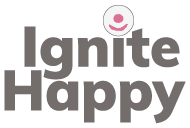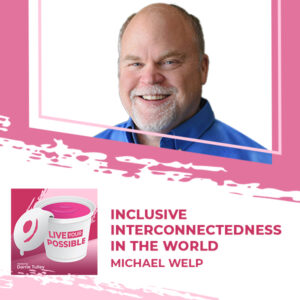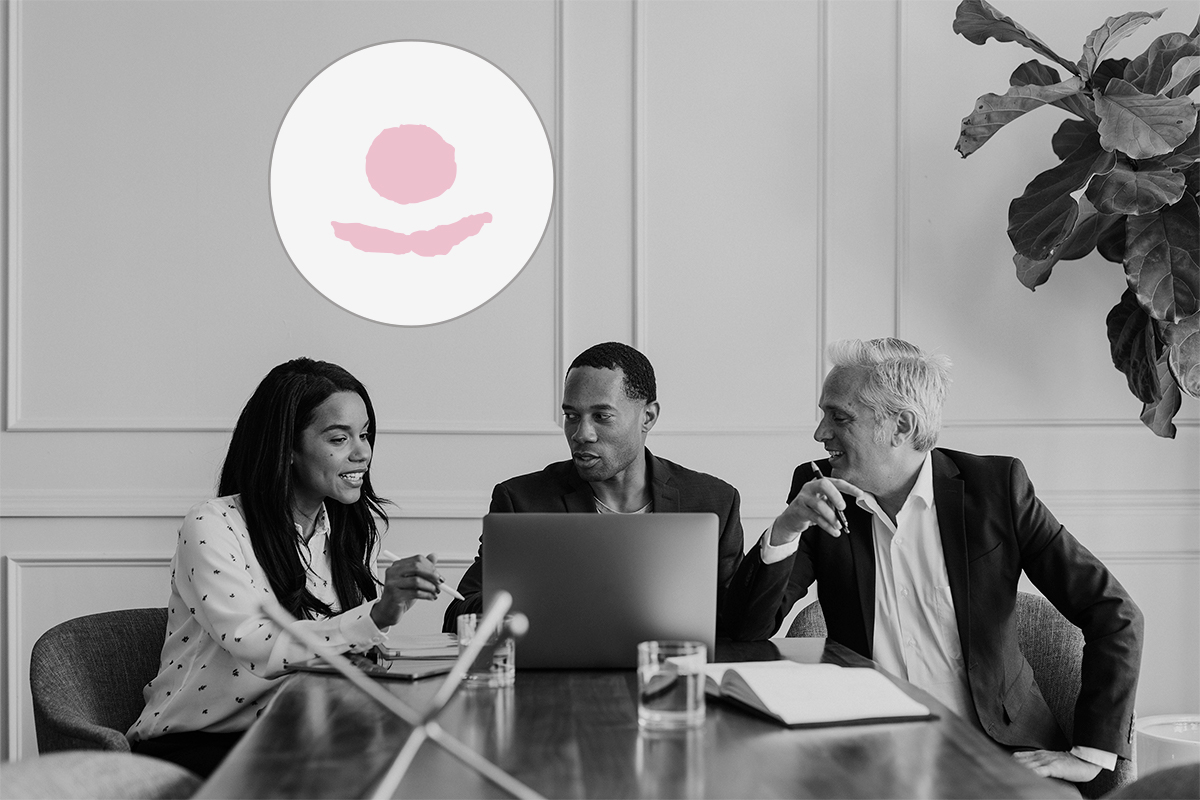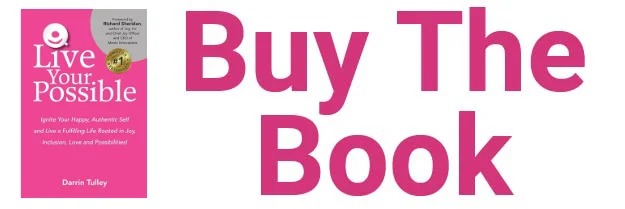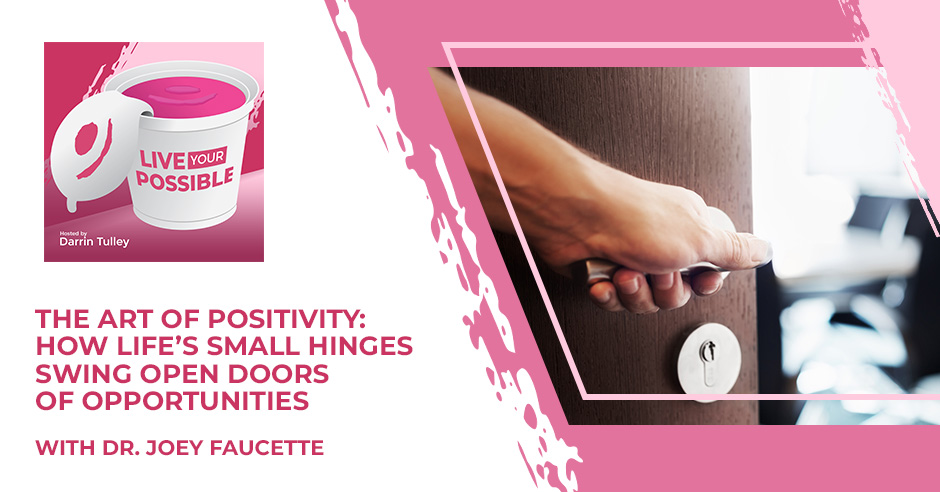
There are these small hinges of positivity in your life; they swing open the doors to boundless possibilities. Work positively, live your best possible life, and let the world see your brilliance. In this episode, we are joined by the uplifting Dr. Joey Faucette, author of Small Hinges Swing Big Doors, to discuss the essence of a positive work culture, resilience in the face of adversity, and the transformative power of gratitude. Dr. Joey shares his core practices for cultivating a positive work culture: perceiving, conceiving, believing, achieving, and receiving. He explains how work positivity is about more than just profits; it’s about connecting people and profits. Dr. Joey then explores the important role of small changes, or “small hinges,” in swinging open big doors of opportunities. Who doesn’t want to work positively and live a life filled with opportunities? Tune in now and start your journey towards a brighter, more fulfilling future.
—
Watch the episode here
Listen to the podcast here
The Art Of Positivity: How Life’s Small Hinges Swing Open Doors Of Opportunities With Dr. Joey Faucette
Welcome, Dr. Joey. It’s so great to see you. How are you doing?
Darrin, I am so ecstatic to be on. I love the title of your show. If I were hosting my show, which you were on, I would say, “Where did you get the title?”
I love yours, Work Positive Podcast. I appreciate you joining and sharing your positivity with us. Let’s start there. What are you passionate about?
We were talking previously about my granddaughter. I am passionate about her. I’m the certified best Pops ever.
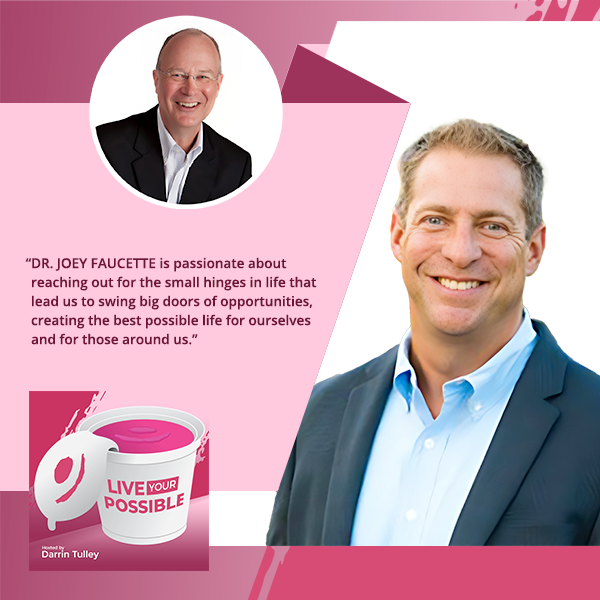
Should I call you Dr. Joey or Pops for the rest of the show?
My preferred pronoun is Pops. I’m from a little South of the Mason-Dixon line or as I prefer to call it Sweet Tea Line. I’m passionate about waking up every morning and opportunities. I’ve programmed my reticular activating system to trigger every morning with the question, “What are you excited about?” That helps me write a beautiful movie for the day and imagine those possibilities. It helps me live my possible.
You’re spot on. If you put those messages into your mind, you start to connect to them and see them as you are living them out loud.
I should read it every year. I reread Dr. Maxwell Maltz’s Psycho-Cybernetics. Matt Furey did a retake on it. I bought that one. That’s a fascinating book. It reminds me of the amazing minds that we have. He prefers to call it the creative success mechanism that we have and how we can use that to our best advantage to create not just the best possible life for ourselves but for those people around us. That’s part of my transformation from me to we. I find that my great passion is around we.
As you talk about our brains, do you think we could train them? Do you think we can control it to continue to deliver on our purpose from me to we?
We can. The cool thing is I can’t capture all of it. In other words, the mind is a battlefield for many of us. I’m figuring out ways to capture our thoughts and to use those to the best possible life. It’s like anything else like hitting a golf ball. My nephew played second base for the Atlanta Braves for ten years. I always go to baseball, and that was my sport when I was a kid. Jesse Cole, the Owner of the Savannah Bananas, has been on my podcast. I’m a baseball nut.
They say, whoever they are, that hitting a 95-mile-per-hour fastball is the hardest athletic feat. To be able to do that, you have to develop muscle memory. You don’t step up there and immediately see it. You have to swing and miss at a whole bunch of 95-mile-per-hour fastballs, but it’s that repetitive motion. Your brain can establish muscle memory, too, so that you have a precognitive response to certain situations. Rather than react, you’re responding in a calculated way.
We’re slowing our brains down to be able to see that pitch coming in either at us or maybe it’s got a different spin on the ball. It’s being able to slow our thinking down a little bit to respond.
Slow down to speed up. It’s the way I talk about it. Michael Jordan used to talk about how the game would come to him. The basket looks big and those kinds of things. It’s that perspective that we bring to our mindset. I know it sounds woo-woo to some people, but there’s too much FMRI research even now showing that you can reprogram your reticular activating system.
The crazy thing is that your brain can’t tell the difference between what’s real-real and what’s imagined. Real sounds redundant, but your brain interprets it all as real. It interprets whatever you’re feeding it, your fear of things that have not happened, and your worries of things that might happen as real. Your autonomic responses and reflexes start triggering. Your cortisol levels go up. I don’t want to geek out on neuroscience because I’m not a neuroscientist, but I love learning about the brain. It triggers these automatic responses. The pulse rate increases and things like that. Slowing down to speed up is capturing your response to it. You can program that.
The fact that we can, knowing that we can and that we can believe that is amazing. We could become aware and care to make some different changes. I had a guest, Debbie Hampton. She is from The Best Brain Possible, and she has shown in her research exactly what you were saying. Our brain is wired in a certain way that it does continue to grow if we feed it the right way.
I have a couple of Ramit Sethi’s courses. I listen to two of his videos every morning. He talks about invisible scripts. I Will Teach You to Be Rich is an amazing book. His great contribution is those invisible scripts. We oftentimes respond based on previous experiences, but more to the point, our interpretation of them and how we show up with those are invisible scripts that are written for our reticular activating system or the movie going on in our brain. You can edit out certain sections and add new sections.
I love the reference to the movie too. You’re triggering a thought. I used to have a boss who would say, “Stop watching the movie. Get in the movie.” I thought that was pretty insightful.
Life is not a spectator sport. You’re the star of your movie.
You are the star unless you want to sit there. I love your motivation, and I would love to learn a little bit more too. How did you get from me to we thinking? How did you transform that way? That’s the word that you mentioned there.
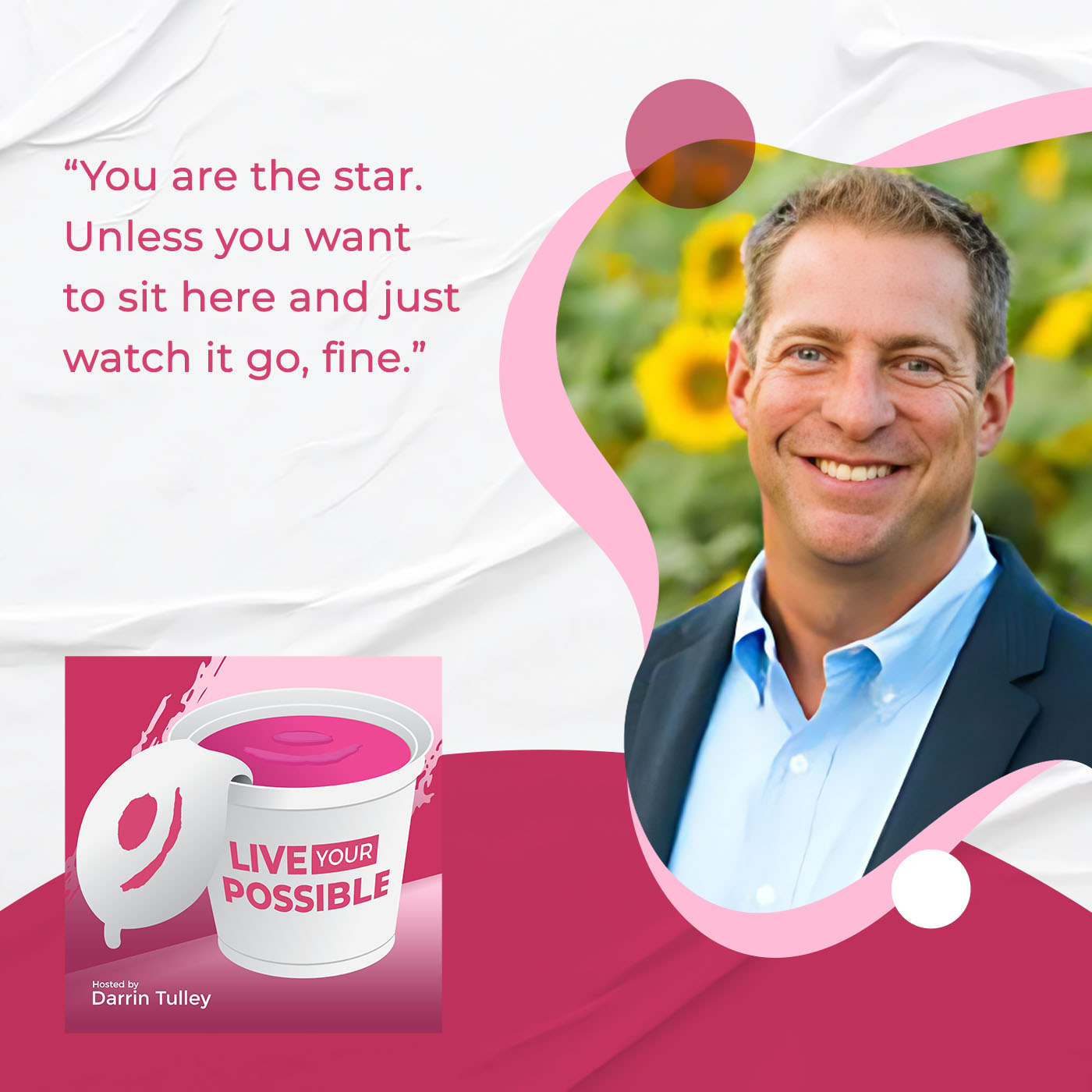
Exhaustion and burnout.
You experienced that.
I lived it. I was having a conversation with someone, and I made the statement, “I’m glad I’ve lived long enough and still have enough life left to have learned a few things that I can enjoy the benefits of now.” We have two daughters. I was a good dad when they were growing up. I’m an even better Pops not because of the release of responsibility for primary parenting. She’s with us five days a week in the afternoons. We get to interact with her. We’re going through those wonderful three-year-old exertions of personality to declare her independence. She can do things.
We’re seeing that. Every now and again, we need to learn emotional governance. We have opportunities to do that. I’m much more patient with her. We sit down and talk about things when she’s emotionally needing to get herself under control. Her mom, because we did it when she was young, helps her to take a minute. That has become a phrase for us, “Little girl, would you like to take a minute?” She will sometimes take herself to take a minute.
At three and a half, she’s becoming emotionally aware enough, “I’m not at my best. Let me step aside and isolate myself where I get my act together.” She has her room here with her nap bed. She comes out of her room here, and she will yell to my wife, “Gigi, I’m ready,” because she’s got herself together. That’s another way of editing a movie. She’s learning emotional intelligence even at that young age.
Having experienced burnout, having tried to do it all myself, and realizing not only the effect that was having on me, I’m also denying other people the opportunity to live their best life possible. That does not make me a very good steward of the human experience. Part of my mission in life is to maximize my potential. I wasn’t doing that. I’m getting vulnerable and honest with myself about some insecurities that were driving me to try to prove myself constantly and prove my competence.
Part of that is my personality type. Thank you, Myers-Briggs, for helping me understand that. However, rather than use that as a crutch, I said, “I recognize that this is what I do. How do I make better choices so I can live my possible even better?” Pain is a great teacher if we allow it to be, not that I wake up in the morning and say, “I hope something screws up so I can experience some pain,” but things are invariably going to be less than. Do you know how your math teacher taught you less than and greater than? There are going to be some less than experiences in the day. What do I do with those? Do I react or respond?
You created a new dance, the less-than or the Pops dance.
A 63-year-old bald-headed white guy may not be the one who makes it on TV with dance moves.
Do you want to respond or react? Those are great. There are specific steps you might have taken as part of that journey. It’s wonderful. You took a minute to reflect. You’re not being the person you want to be or could be or how you want to teach and reflect in the world. You said, “I have to make this change happen.” How did you make the change happen?
It’s not that old dogs can’t learn new tricks. It’s that old dogs first have to unlearn the previous trick and then learn the new trick. It’s almost like you have to create RAM in your brain. William James, the father of modern psychology, was fond of saying that we’re bundles of habits. It’s an autonomic response. That becomes a reaction. I don’t think when I do something.
It's not that old dogs can't learn new tricks. It's that old dogs first have to unlearn the previous trick. Share on XBeing an executive coach and ICF-certified and all that did a great job of training me and teaching me that new awareness is the first step. As a coach, what I’m doing is using powerful questions to help people gain new awareness as we reflect on their experiences and then aligning action with that new awareness because new awareness doesn’t count until you act on it. I’m fond of saying, “Learning is better behavior.” It has to drill down into a change in behavior.
What can I do? That awareness extends into, “How am I acting? How do other people see me acting?” This is back to the transformation from me to we, having a few close friends that I can say, “I don’t think I was at my best there. What did you see? That seemed like a great experience to me. What did you observe?” It’s a matter of making yourself vulnerable and being authentic with a few close friends who will give you that observation and then collaborate with you around it.
I use observation and collaboration instead of feedback. Somebody walks up to me and says, “Can I give you some feedback?” Immediately, my stomach acid churns because it is never a good thing when I say, “Can I give you some feedback?” They’ve got a point to prove or something to drill on in me, but observation and collaboration are more objective. It’s less emotionally charged. It’s easier to hear and act on.
I love that perspective. I also appreciate the thought that we can learn from anything, pain, success, how people are reacting and giving us observations, and that type of thing. When you say, “Unlearn and relearn or learn new things,” isn’t that the growth mindset definition?
We’re talking about the fixed versus growth mindset.
I think about what you’re doing out in the world, and I want to jump into that. You have some wonderful things you’ve put out in the world that you’re doing. You have the highest purpose or cause. Do you have a certain word, a phrase, or something that you work with every day? You have that as part of your opening every morning as you wake up with the chickens.
I get up before the chickens most mornings. They haven’t crowed yet. I’m sure they’re out there. Those are my neighbor’s chickens. I’m still working on my wife to allow me to have chickens. We’ve got 22 acres here. There has to be a little land I can put some chickens on. I do choose a word a year, and that’s my personal word for the year. I typically choose a song that goes with it. That guides it.
My coaching partner, Jane Creswell, connected us with a calligraphy artist, one who does calligraphy but does an artistic expression of it. We get her to do a 9×12 interpretation of our words each year. That’s the visual representation because I’m a visual and tactile learner. I try to engage all my styles. That’s a daily reminder, “Here’s what you’re supposed to be about. Here’s what you chose to be about this year.”
What is that word? I know my audience is saying, “What’s the word?”
That’s in the other office over there. Here in the studio, I do have previous years’ words. We have a team word also. My word for this year is steward, both people and other resources as well as maximizing potential. I want to make sure I’m stewarding the human resources as well as other types of resources around me. Time, energy, and attention are a resource.

The older I get, the more strategic I am. My priorities become more defined because being Pops has bumped up the list greatly. When the little girl wants to go with me to feed a horse in the evening and take the doctor kit that her mommy and her aunt played with to listen to the horse’s heartbeat and that stuff, we’re going to take a few minutes, and do that. Whatever chapter of a book I’m writing or something can wait a little bit.
What’s the song that goes with it? I’m trying to think of one that connects to the word stewardship.
There’s a song called Thank You by Ray Boltz, which is an older song. It’s not all the way back to my childhood. I grew up in Motown mostly. Ray Boltz is not Motown. I love Motown but I love Eagles too. Thank you to all the people in his life who gave and made significant contributions to him. I listen to the song every morning. When I’m listening to it, I remember people like Archie Mosley, my high school baseball coach who invested in me in so many different ways, and Charlotte Forest, my high school geometry teacher who invested in me in ways outside of class.
I’m remembering Ms. Anderson, my fifth-grade teacher who came to me and said, “I want you to enter this oratorical contest that the Optimist Club is sponsoring.” I’m like, “What kind of contest?” She said, “Oratorical.” “What does that mean?” She said, “You give a speech.” I was like, “I could never do that.” “You can, and you will. I’ve already spoken with your mother.”
I won third place in my very first year. Here I was in fifth grade competing against high school students and Toastmasters. People pay me more money than some of them should for me to stand on platforms and talk about how you create a Work Positive culture. It’s good for me in gratitude to remember. Therefore, that gratitude becomes my springboard into serving others so that I’m a steward of the opportunities that I’m giving each day.
You’re living this out loud by example. You’re living your possible and your teaching. That’s the ultimate place for anyone. When you get to the point where you want to teach this, and it’s giving out a greater purpose, better possibilities, love, or happiness elsewhere, that’s the greatest gift. You’re there. I’m proud of you. I’m honored to be talking with you about all of this.
I appreciate you saying that. That’s very kind of you. I find that teaching is the best way to learn because when I’m teaching, it means I’m digging a little bit deeper into who I am and into the source materials around me. I’m accessing more of that. There are almost eight billion people here. I have a lot to learn because every person is unique. There’s a ton to learn from everybody. Anytime I’m meeting someone, that’s the question in the forefront of my mind, “What can I learn from this person? There’s something unique about that person.”
Teaching is the best way to learn. Share on XI know you have the podcast Work Positive. I have this beautiful cup for being a guest. Thank you again for that.
You’re welcome.
You talk about learning. We talked a little bit about how much you’re learning. You did a recap of your first season. You outlined six themes. Tell us a little bit more. What are you learning from the show? What is a sample of some of those themes that you’re encountering in what you’re learning?
I don’t have all six in my head but two come to mind pretty quickly. One is we have yet to figure out the physicality of work. We’re in the process of that. Do we come into the office or a physical space? Everybody comes into that as we did pre-pandemic. Do we allow some people who want to come in to come in and other people to not come in? Do we require people to come in for 2 or 3 days?
Jassy, the CEO of Amazon, said, “If you don’t want to come into our offices, you probably aren’t going to last very long in Amazon.” That’s a bit of a paraphrase. Elon Musk said, “Everybody who’s working X is going to have to come into the office.” There’s this huge question around what leads to most productivity, but there’s an even greater question, at least for me, and that is related to the definition of work.
I am excited every day by what we’re doing to redefine work. That’s a big and broad context of the landscape. My dear friend Dr. Bob Johansen is a futurist. He was around when the internet was created. I know you thought Al Gore did it, but it was the Department of Defense back in ’73 and the ARPANET, which was a precursor to the internet. There are distributed networks everywhere around us.
Bob is doing some fascinating work with major household-name corporations to develop new campuses that take advantage of what he calls the officeverse. That’s a combination of metaverse and office. His latest book, Office Shock, is amazing. I would say it set my hair on fire, but nobody would believe that if they looked at this or think that it did, and maybe that’s what happened.
I agree with him. Bob talks about augmented intelligence as opposed to artificial intelligence. How can we augment ourselves, which we’re already doing anyway? How can we augment ourselves for greater engagement or productivity and things like that? There are certain things that computers can do better than we humans can. Most of those are repetitive tasks, but there is still the innovation and creativity that even generative AI can’t quite get to.
The redefinition of work allows us to capture the human spirit in fulfillment, satisfaction, meaning, purpose, and things like that through our work. I think of it as a great redefinition of work. That’s what we’re on the cusp of now. We’re beginning to understand what that means, but this whole physicality question is one of the big nuts we have to crack if we want to get to the meat of what’s going on in work.
The other thing is I am thankful that we can now have mental health conversations. It comes at a cost though. During the pandemic, we saw antidepressants and anti-anxiety meds and things like that. Those prescriptions go up 30% or maybe even higher now. I haven’t checked in the last few months. That’s a lot. We’re allowing ourselves to have those mental health conversations, which can be something as simple as, “How are you?”
We’re moving from an assembly line understanding of work and humans at work to productivity, engagement, alignment of the purpose of the company and the individual, and those kinds of things. Those are three of the exciting things. I said three because I worked in augmented intelligence, talking about physicality. Those are three things that are fascinating in culture. The companies that are attracting top talent, reducing team turnover, and increasing productivity and profits are the ones that are capturing those three conversations and leading in those areas with their people.
You talk about on the show that last word, people, or that element of humanity. It’s important that we’re bringing humans into the conversation back into the workplace about mental health. We can say things and share things we’re a little bit more vulnerable about or maybe we couldn’t say in the past. People are feeling like they can belong as more of themselves, maybe not fully yet more.
There’s a term you use, becoming. There’s a becoming aspect in the workplace and a lot of wonderful things. You have a couple of books that I’m pretty aligned with. One was a bestseller, which we will talk about. You had one that came out. Hopefully, I’ll get eight billion views and downloads, Small Hinges Swing Big Doors. I have mine on the way. I’m looking forward to taking a read. I would love for you to describe what that’s all about.
It became a bestseller on launch day as well.
Congratulations.
I’m very grateful for that. It’s the first book of its type I’ve written. It’s a short book. What I’m discovering is now that I can churn out short books rather than writing a 240-page book or something like that, I can write less than 100 pages, and people are interested in reading that. Small Hinges Swing Big Doors is rooted in the basic notion that Jim Collins was right. We need big, hairy, and audacious goals. We need BHAGers. You don’t need me to tell you Jim Collins is right. Jim Collins is right. However, I am equally convinced that BHAGers constitute a very small percentage of the population. Those are very special people who are visionaries.
All of us can do one thing or DOT. That’s the way I like to think about it. We can do one thing. We can be DOTers. These small hinges that swing these big doors are what constitute that book. They’re wrapped around the five core practices of a Work Positive culture, and they are very practical things that you can do to move your culture and transform your culture toward more positivity. It’s written short. It has a killer cover. Kristen did an amazing job with the cover. I like it.
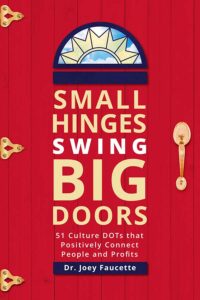
The subtitle is 51 Culture DOTs that Positively Connect People and Profits.
Businesses have to stay sustainable to take care of people. Our families who work for our companies are dependent on us to keep our company sustainable. Profits are important. It’s not either/or. We want to connect people and profits.
I like the order too. People lead to profits. We can reinvest back in our people, the assets, and the investments or infrastructure we need so we can continue to deliver the services we committed to, whatever that might be. Without people, it’s hard to deliver.
It depends on what you’re delivering. With automation coming along, back to the augmented intelligence thing, there are certain goods and products that you can deliver. I have a friend in the logistics business. The pick-and-pack automation now that they have there is how you get that cardboard box on your doorstep the next day. It’s because of that level of automation. However, this is the redefinition of work. Even generative AI can’t get close to innovation, creativity, paradigm shifts, and disruption. Those kinds of things take hours to do as human beings.
Creativity is fascinating. We talked about this on your show. Some of this research points to a small percentage of adults who show the ability to be creative. Do you remember the answer to that percentage?
I do not.
In certain studies, 2% of adults show that they’re able to be creative versus the average five-year-old. Ninety-eight percent show the ability to show creative thinking and skills to resolve the same problem. Think about that. What happens?
That’s the cumulative effect of work as we have defined it previously. We corral the human spirit in such ways as we lose that joie de vivre.
How did that happen?
I don’t want to gloss too big over historical trends. There are multiple causalities for this. I mentioned it earlier. We go back to Henry Ford and the assembly line mentality. That’s one of the exciting things about the redefinition of work now because automation and robotics now dominate, for instance, car manufacturing lines and other manufacturing lines, which releases more of us to live into that creativity.
We become the designers of the cars, the robots, or the bolt that goes in that right place with the greatest tensile strength, the fewest number of turns, and those kinds of things. We can do the higher-level thinking. It became formalized at that point with the assembly line, but prior to that, there were historical trends in play already that were suggesting that we could use people to do repetitive tasks and stifle the creativity right out of them.
We’re not as motivated. That’s taking its path and course over time in different jobs. To your point about saying hello again as a leader, it’s saying hello and listening to what someone says. I’ve done it myself, being from the Northeast, “How are you?” You keep walking.
It’s a grieving as opposed to an inquisitive or curious nature.
Talk about a habit. That’s a bad habit, “I’m not listening.”
Let’s say they’re more effective habits than that one.
You have another bestselling book, Work Positive in a Negative World. Are there some suggestions in that book that you could help us think about to help us work positively in a negative world?
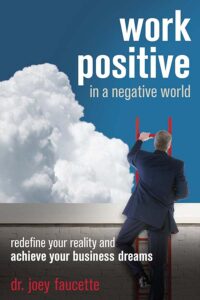
That book that came out in 2020 was the Team Edition because the first edition came out in ’11, which came out of the research I did during the Great Recession since I didn’t have anywhere to go and any work to do. When your wife looks at you and says, “Isn’t it time for you to travel?” she’s concerned about the revenue for the family or she’s tired of looking at you, or a combination.
There are lots of suggestions. I’ll very quickly go over the five sets of habits that I like to call core practices. The first is to perceive. That’s the mental dynamic. It goes back to what we were talking about earlier to train your brain to focus on the positive and filter out the negative. It’s not some Pollyanna. There’s nothing negative, “We need to stay positive.” It’s not that at all. It’s far beyond positive thinking.
Dr. Norman Vincent Peale’s book from 1952 was highly influential on me, as was Napoleon Hill’s Think and Grow Rich. However, it’s focusing on the positive while recognizing the negative and seeing it but you filter it out. The second thing is the conceive core practice. This is a social dynamic of relationships. There are very specific tactics in there for how to deal with negative people without becoming one yourself. I like to call negative people as a class Eeyore Vampires.
I specifically talk about managers who are Kevins and the creation of Kevin culture in most businesses. That was why the Great Resignation was followed by the Great Regret because we discovered that Kevin was everywhere. He’s in every culture. What are the five key characteristics of Work Positive dream teams? How do we develop those in our people? You perceive it mentally. You conceive it socially. Thirdly, you believe it emotionally. This is the place where you give serious attention to engagement.
Gallup found in their last poll that 85% of American workers say they’re disengaged at work. That number was up a little bit from about 72% to 73% to 85% during the pandemic. It will be interesting to see what happens post-pandemic in the next survey they do. Once we engage in innovation and creativity, the kinds of things we were talking about a moment ago come to bear. We belong and become because we’re connecting our daily tasks with the company mission and see ourselves as a part of a larger whole and making a contribution.
The fourth thing is we achieve it. This is the physicality of it. These are the things that we do. Our productivity increases because we’re focusing on the positive and filtering out the negative. We’re focusing on positive people and choosing to spend less time with the Eeyore Vampires. We also are engaged with our work. It naturally follows then because motivation is an inside job, and learning is better behavior. Our actions are more guided, strategic, as well as tactical toward getting results, as my friend Jody Thompson likes to talk about.
Receiving is the fifth core practice. When I did my study on guys and gals I call Great Depression gurus, I thought the achieve core practice was the last one. You perceive it, conceive it, believe it, and achieve it. What else is there? You hit your goals. The results are outstanding, but that fifth dimension is what accelerates the continuation of the five core practices.
I’m expressing gratitude. I’m becoming aware of my gratitude. I’m expressing that in service to others. Service then is motivated by gratitude for recognition that I have achieved because I believed, conceived, and perceived. I discovered great ways of saying thank you to Darrin. That’s why you have what my granddaughter calls a birthday cup for being on my show. I wanted to say thank you to you and let you know how special that was for me to have you on the Work Positive Podcast.
It’s things like that in service to others and expressing gratitude that keep those five core practices going. That book is full of all kinds of strategies. It’s my manifesto about the Work Positive framework. We’ve got courses online at WorkPositive.Today like the 7 Keys to Work Positive Coaching Program and others that drive you deeper into tactics that you can begin implementing in your work culture.
Thank you for sharing all of that. That’s so insightful. I love the nature of how it’s continuous. It’s not like you go through the experiences, and you’re done. It’s going to be an ongoing learning loop. You’re giving us the tools to practice every day.
Practice is the right word. There’s always room for growth and improvement. It’s personal and professional. I like to call it development. It does continue, not just for our benefit, but we have made that transformation from me to we for our team, the company, our community, and eventually the world.
There's always room for growth and improvement, and it's personal and professional. Share on XYou have such a nice way about you, Dr. Joey or Pops. I’m curious too. Going back to your childhood, are there certain stories or memories that shaped you for who you are that you reflect on? You’re so positive, grateful, and appreciative. You’re always smiling and learning. That’s what we were like when we were kids. We’re always learning.
I’m a big kid. My wife would tell you that I’m stuck at seventeen. I’m not sure she means that as a compliment sometimes.
That means you’re always curious and looking at the world in a different way.
I am filled with awe and wonder. That regenerates me daily, but in terms of those transforming experiences that I had when I was a kid, there were a bunch. One in particular was when I was about nine years old. I did what I thought every nine-year-old wanted to do, and that was make money. You’re not depending on your parents for an allowance, maybe not so now.
I borrowed a lawnmower and went and mowed a lawn. I quickly discovered that I’m allergic to grass, especially mowing grass so much so that I came down with a viral infection in my lungs. I was at Duke University Medical Center for about a week, sick. I can remember being under a mist tent. I don’t think they use these now. They were misting O2 in the air or some medicine into this tent. What we didn’t know is I was allergic to that medicine too. I was coughing. My O2 levels were way down, and my skin tone was turning green and then blue.
My mom got the doctor in there. Unfortunately, the doctor wasn’t on call, but the internist was. I remember the internist saying, “Pray he makes it through the night.” I’m nine years old, and I’m hearing that. I’m scared to death, coughing my lungs out. I look at Mom. She reaches under the mist tent, takes my little hand, and says, “I’m positive you’re going to make it through the night.” She spoke that truth to me, and I believed it because she was my mom. She knows everything. At that point in my life, she was still making everything better.
I made it through the night. Fortunately, the doctor came around the next morning. Dr. Susan Dees at that time was the foremost pediatric asthma allergy specialist in the world. You see the resources that came to me there. She said, “Get him out of that tent. He’s allergic to the medicine. Why didn’t you think of that?” I remember that. I got well, came back home, knew I still had this entrepreneurial spirit, and knew I wasn’t going to be able to mow grass.
About that time, arrived in my mail a big manila envelope 9×12 from the Sales Leadership Club. This was years ago when I was nine years old. You could then sell and therefore buy inscribed Christmas cards. Back then, everybody went to the painstaking trouble of writing their names on Christmas cards, but with this nouveau technology, I could write your name down on a form and send it to the company, and they would send you a box of Christmas cards with your name inscribed on it. It was a big deal back then.
I said, “I can do this. I don’t think I’m allergic to Christmas cards.” Here I am going door to door in August. It’s 100 degrees in Eastern North Carolina with 100% humidity, and I’m showing people Christmas cards with Frosty the Snowman, Rudolph, and baby Jesus in snow scenes and saying, “How many Christmas cards do you want?” I was a cute nine-year-old kid. I got enough credits and money built up to get a three-speed bike, which was the latest technology. Cassette decks had just come out then. I got a new cassette recorder and a telescope. I gave that telescope to Goodwill a few years back. I could see the moon and the heavens.
From that experience, I learned perseverance through adversity. That set up my high-performance pattern. Our company uses a narrative approach to helping people discover their high-performance patterns. That’s one of my pivotal stories or transforming experiences. I respond to adversity with perseverance and find the opportunity in it. That’s one of the things that formed me and shaped me.
Thanks for sharing. It’s a beautiful story of your mom setting that direction for you. She believes, and you believe them.
The cool thing is mom is 83. I’ll be with her. She has cancer. She was taking another treatment. She and my dad both have cancer. The roles have been reversed somewhat now. I find myself with the incredible opportunity to repay some of that debt. She spoke that truth in my life. Now, it’s my turn to speak that truth and try to provide for her what she needs as she enters the sunset years of her life.
Help her believe, get her mindset there, and give her a big hug for us and our thoughts with all of you.
Thanks. I appreciate that. It’s a privilege. It stretches me because you’re Pops over here, and then you’re medical POA to your parents over here. You’re running a business in the off hours.
To that point, you are an entrepreneur. You have this radio voice. Have you been on the radio before?
I expected you to say I have a face for radio.
You have your portrait behind you.
That reminds me of that nine-year-old kid.
You’re very handsome, Pops.
Thanks. I appreciate that. That’s a funny joke for us guys in radio or former radio guys. That was another adversity back in the mid-’70s. Some of your audiences may have read about it in history books. Others might have lived it like I did. We were in gas rationing lines on odd and even days and things like that. The company my dad worked for went bankrupt. I found myself as a sixteen-year-old staring down college costs in a couple of years with a dad who was out of work.
The economy wasn’t supporting a whole lot of economic growth at that time. I said, “What’s something that I’m doing? What’s an asset that I have?” Responding to adversity and looking for opportunity is my high-performance pattern. The adversity was I wanted to go to college, and my dad was out of work. Mom did not work at that time outside the home.
What asset do I have? I had spoken to groups because Ms. Anderson prompted me to. I also narrated some musicals and things like that. People seemed to respond to my voice well. I went to see Bob Harper who owned a local AM and FM radio station, “Do you have any experience?” “I’ve narrated these musicals, but I’ve never been on the radio.” Friends of mine have told me in entrepreneurial groups I’ve been in, “You’re fearless.” I’m like, “I probably don’t have enough sense to know to be scared.”
That’s a skill.
I rush you in where angels fear to tread. Two hours later, I had a job at Bob Harper’s radio stations, and six months later, I had the number one-rated afternoon drive show in North Carolina. I would get out of school, go to the radio station, and do drive time.
Congratulations. What about it made it number one?
The number of people listening.
What made it exciting for them to listen?
First of all, I was very coachable. Secondly, Bob was a great coach. I knew I didn’t know what I was doing. Something that’s lost now is the ability to say, “I don’t know.” It’s okay to say, “I don’t know,” and to learn something because that admission creates reciprocity with other people and releases them to say, “I don’t know either, but we can figure it out.” I knew I didn’t know. Therefore, I was coachable. Thirdly, country music was evolving at that time beyond what it always had been. Urban Cowboy came out. We led up to Urban Cowboy at that point in time. I was country before country was cool, Barbara Mandrell and myself. We had a ton of people listening.

Do you remember the first song you played?
I do not. I can name you some of the songs. Outlaw country music was big then like Waylon Jennings and Willie Nelson who’s about 90 now or something.
He’s still playing too, which is unbelievable.
I interviewed Jamie Weeks for the Work Positive Podcast. Jamie is an incredible entrepreneur who focuses on empathy and creating a positive work culture. When he is interviewing people, he asks them three questions. One, what was your first car? Two, what was your first concert? Third, what movie can you watch over and over? That first concert for me was Willie Nelson. I managed to see Willie Nelson. Those three questions are powerful in the interview process. My first car was a 1979 Toyota Corolla five-speed. It had an AM radio.
That’s good to learn on the stick too. My first concert was Kiss with full makeup.
Gene Simmons would be proud. They were excellent marketers like Jimmy Buffett. They’re much better marketers than they were musicians, but we all love their music.
It’s true. God bless Jimmy Buffett too. What are you up to these days? It sounds like you have a lot of fun with what you’re doing. What do you do outside of all the positive work, your coaching, and your writing? What else are you doing for fun?
I’m creating courses. That transformation from me to we has put me in touch with so many incredible people, particularly guests on the Work Positive Podcast. We’re creating video-based courses that we put online on our website at WorkPositive.Today. I have conversations with people about various things. I was talking about Bob Johansen earlier. He’s one. Putting those courses together is a lot of fun. Work for me is fun because I choose fun work that suits me.
If you’re talking about outside of Work Positive, we live on this little 22-acre farm. I still have a lot of plans for doing things. We’ve got some woodlands that we’re going to harvest and then replant back. I’m working with some local government and state-sponsored officials to figure out how to create an environment that’s best suited to the native habitat of deer, turkey, and things like that around here and how we can create regenerative agriculture around here for them. That’s a lot of fun. I’ve got an area planned for orchards. I hope to build a pond also to provide water for the wildlife. I have a tractor. I know how to use it. That’s a lot of fun. I also hope to get back into horses as the little girl gets a little older. I’m hoping her mom and dad will let me buy her a horse or at least a pony.
I love it. You’re a proud Pops as you started the show. That’s fascinating. I’m excited for you. It’s wonderful to me. You’re like a candle. You bring warmth and light to all of us. Thank you for everything you’re doing. Are there any final words you would like to share with our audience about anything that might inspire them to take positive action?
If I can do it, you can do it. Please avoid that mentality of saying, “That’s Dr. Joey.” You can do it too. I promise you can. Darrin’s great book will help guide you through some tactics that you can pick up and start doing. Live your possible. Throttle back on thinking, “I can’t do that for 10 years, 5 years, 10 months, or 10 days.” Do it and focus on doing that one thing that’s going to move the needle as you transform from me to we and live your best possible life out of gratitude. You got this. You can do this.
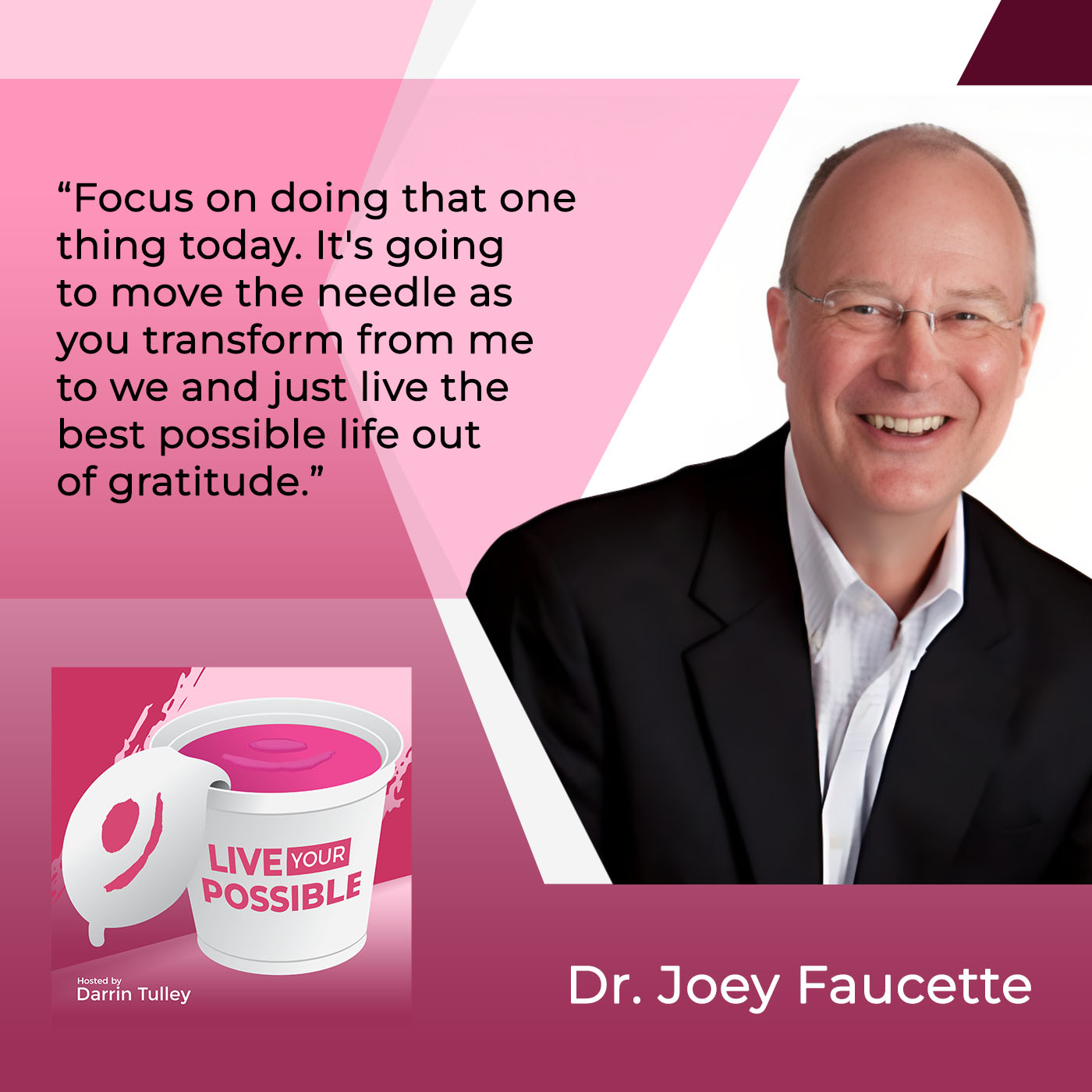
Dr. Joey, this has been fabulous. Thank you for joining us, my friend. I’m honored to know you and blessed to be part of your world. Thank you for joining.
Darrin, the pleasure has been all mine. Thanks. This has been a fun conversation. I’ve enjoyed every second of it. Thank you, my friend.
We will be in touch soon. Take care.
There are these small hinges of positivity in your life; they swing open the doors to boundless possibilities. Work positively, live your best possible life, and let the world see your brilliance. In this episode, we are joined by the uplifting Dr. Joey Faucette, author of Small Hinges Swing Big Doors, to discuss the essence of a positive work culture, resilience in the face of adversity, and the transformative power of gratitude. Dr. Joey shares his core practices for cultivating a positive work culture: perceiving, conceiving, believing, achieving, and receiving. He explains how work positivity is about more than just profits; it’s about connecting people and profits. Dr. Joey then explores the important role of small changes, or “small hinges,” in swinging open big doors of opportunities. Who doesn’t want to work positively and live a life filled with opportunities? Tune in now and start your journey towards a brighter, more fulfilling future.
You too.
Important Links
- WorkPositive.Today
- Work Positive Podcast
- Psycho-Cybernetics
- Debbie Hampton – Previous Episode
- I Will Teach You to Be Rich
- Office Shock
- Small Hinges Swing Big Doors
- Work Positive in a Negative World
- Think and Grow Rich
- Jamie Weeks – Work Positive Podcast Episode
- https://www.WorkPositive.today/darrin-tulley
- https://www.WorkPositive.today/drjoey-season1-recap
- https://ignitehappy.com/retrain-your-brain-to-change-your-life-with-debbie-hampton
About Dr. Joey Faucette
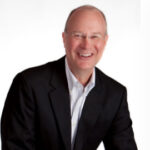 An executive coach, culture architect, and host of the Work Positive podcast. His best-selling book, Work Positive in a Negative World: Team Edition, is the manifesto for developing your positive work culture. He has spoken to thousands of people within companies and associations annually for decades.
An executive coach, culture architect, and host of the Work Positive podcast. His best-selling book, Work Positive in a Negative World: Team Edition, is the manifesto for developing your positive work culture. He has spoken to thousands of people within companies and associations annually for decades.
Dr. Joey is a prolific writer of over 1,000 articles that have appeared on the websites of Fox News, CNBC, Wall Street Journal Market Watch, MSNBC, Entrepreneur.com, and countless others. His content reaches people in more than fifty countries.
He and his wife have two adult daughters and son-in-laws, the most brilliant and beautiful granddaughter ever born, four grand-dogs, and enjoy living on Pleasant Gap Farm with their two cats, horse, and Maggie Mae the yellow Lab.
